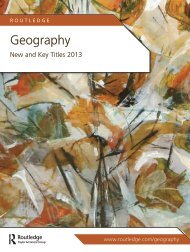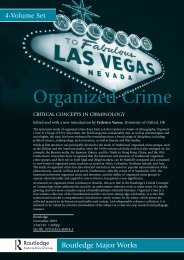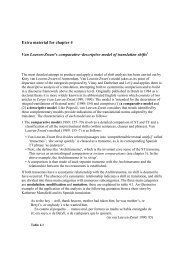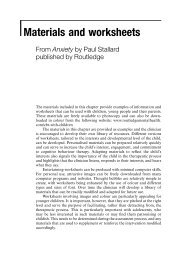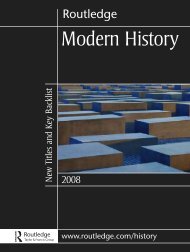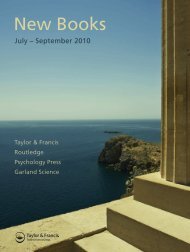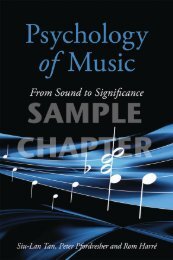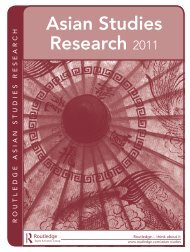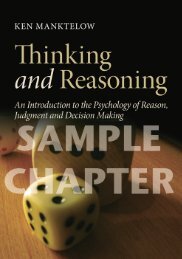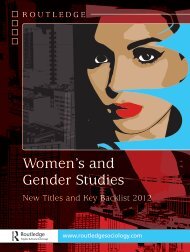Tim Burton: The Monster and the Crowd - A Post-Jungian Perspective
Tim Burton: The Monster and the Crowd - A Post-Jungian Perspective
Tim Burton: The Monster and the Crowd - A Post-Jungian Perspective
You also want an ePaper? Increase the reach of your titles
YUMPU automatically turns print PDFs into web optimized ePapers that Google loves.
Introduction 11<br />
that `<strong>Tim</strong> can't tell a story out of a paper bag'. [. . .] And every time,<br />
when <strong>the</strong>y're developing a script <strong>and</strong> you're talking to <strong>the</strong> studio <strong>and</strong><br />
you have <strong>the</strong>se stupid meetings with <strong>the</strong>m, I can say that if <strong>the</strong>re is a<br />
problem with <strong>the</strong> movie it is nothing that you discussed. [. . .] And<br />
Beetlejuice was kind of <strong>the</strong> one movie that gave me, again, that feeling<br />
of humanity, that F**k Everybody! That made me feel very good, that<br />
<strong>the</strong> audience didn't need a certain kind of thing. Movies can be<br />
different things! Wouldn't it be great if <strong>the</strong> world allowed David<br />
Cronenberg to do his thing <strong>and</strong> people could tell <strong>the</strong> difference! And<br />
criticism would be on <strong>the</strong> whole o<strong>the</strong>r level! And <strong>the</strong> world be on <strong>the</strong><br />
whole o<strong>the</strong>r level!<br />
(Fraga, 2005: 57)<br />
`<strong>The</strong> difference', one might assume, lies in <strong>the</strong> amount of `noise' that<br />
gradually creeps into <strong>the</strong> ®lm in <strong>the</strong> process of its evolution from <strong>the</strong> initial<br />
concept to <strong>the</strong> ®nal product. All <strong>the</strong> while, <strong>and</strong> ra<strong>the</strong>r contrastingly, <strong>Burton</strong><br />
has respect for <strong>the</strong> people who h<strong>and</strong> out <strong>the</strong> cash, <strong>and</strong> willingly acknowledges<br />
<strong>the</strong> ®nancial responsibility for his creations: `I've never taken <strong>the</strong><br />
attitude of <strong>the</strong> artiste, who says I don't care about anything, I'm just<br />
making my movie. I try to be true to myself <strong>and</strong> do only what I can do,<br />
because if I veer from that everybody's in trouble. And when <strong>the</strong>re is a large<br />
amount of money involved, I attempt, without pretending to know what<br />
audiences are all about, to try <strong>and</strong> do something that people would like to<br />
see, without going too crazy' (Woods, 2002: 51). <strong>Tim</strong> <strong>Burton</strong> is not a purist;<br />
he had always had an eye on <strong>the</strong> commercial side of <strong>the</strong> movie business. In<br />
some of his interviews he expressed ra<strong>the</strong>r anti-auteurish opinions: `I care<br />
about money, which is why I get so intense when <strong>the</strong>se people are on my<br />
case saying I don't make commercial movies, because I've always felt very<br />
responsible to <strong>the</strong> people who put up <strong>the</strong> money. It's not like you're doing a<br />
painting. <strong>The</strong>re is a large amount of money involved, even if you're doing a<br />
low-budget movie, so I don't want to waste it (Salisbury, 2006: 51). It is his<br />
attempt to achieve <strong>the</strong> `golden middle', <strong>the</strong> ideal position in <strong>the</strong> triangle<br />
consisting of <strong>the</strong> director, <strong>the</strong> studio <strong>and</strong> <strong>the</strong> audience, that makes him<br />
simultaneously accessible <strong>and</strong>, surprisingly, sophisticated.<br />
<strong>Burton</strong>'s visual style is extremely recognisable despite <strong>the</strong> fact that he does<br />
not harbour ambitions to produce avant-garde works <strong>and</strong> `explore new<br />
artistic territories'. Most of his creative efforts seem to be aimed at <strong>the</strong><br />
elements that are not exclusive to cinema, or, to use Christian Metz's term,<br />
at `non-speci®c cinematic codes' (for instance, soundtrack <strong>and</strong> codes of<br />
visual iconicity shared with painting) (Metz, 1974: 224±235). <strong>Burton</strong> is at his<br />
most con®dent with <strong>the</strong> components that traditionally determine `<strong>the</strong> main<br />
impression', or <strong>the</strong> general atmosphere of a ®lm: visual-iconic elements,<br />
lighting, music <strong>and</strong> story (but not plot). At <strong>the</strong> same time, he does not<br />
worship speci®cally cinematic properties such as sequentiality, movement of<br />
http://www.jungarena.com/tim-burton-<strong>the</strong>-monster-<strong>and</strong>-<strong>the</strong>-crowd-9780415489713



